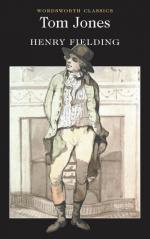|
This section contains 10,181 words (approx. 34 pages at 300 words per page) |

|
SOURCE: "Patterns of Property and Possession in Fielding's Fiction," in Critical Essays on Henry Fielding, edited by Albert J. Rivero, G.K. Hall & Co., 1998, pp. 112-30. Originally published in Eighteenth-Century Fiction, Vol. 3, 1990, pp. 21-42.
In the following essay, originally published in 1990 and reprinted in 1998, Thomspon examines the importance of money and other valued objects in the context of eighteenth-century economic history. Focusing primarily on Tom Jones, Thompson suggests that Fielding's work reflects the instability of money—specifically cash—as a mode of social relations, responding by valorizing land and estates as true and lasting forms of wealth.
Henry Fielding's Tom Jones (1749) tells the history of a number of lost objects which range from the foundling protagonist and his patrimony to wives, daughters, a muff, and several bank notes. The most prominent story of errant money begins with the £500 Squire Allworthy gives to Tom (p. 310), which he subsequently loses...
|
This section contains 10,181 words (approx. 34 pages at 300 words per page) |

|


